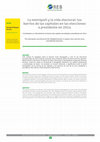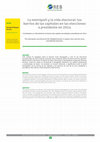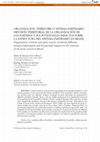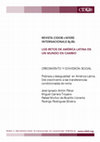Papers by Rodrigo Rodrigues-Silveira

Este trabajo ha indagado sobre la relación entre demografía y voto en las elecciones presidencial... more Este trabajo ha indagado sobre la relación entre demografía y voto en las elecciones presidenciales de 2014 en Brasil, teniendo como unidad de análisis los barrios de tres capitales: Belém, Recife y São Paulo. El análisis de datos electorales y demográficos empleando diversas técnicas-entre las cuales se encuentran la cartografía temática y los análisis exploratorio y multivariado de datos-ha revelado un vínculo coherente y significativo entre el perfil demográfico de los barrios de las capitales y los patrones de voto de los tres candidatos a presidente: Aécio Neves, Dilma Rousseff y Marina Silva. RESUMO Este trabalho consiste em uma indagação sobre o vínculo entre demografia e voto nas eleições presidenciais de 2014 no Brasil, tendo como unidade de análise os bairros de três capitais: Belém, Recife e São Paulo. A análise de dados eleitorais e demográficos empregando diversas técnicas, entre as quais se encontram a cartografia temática e as análises exploratória e multivariada de dados, revelou um vínculo coerente e significativo entre o perfil demográfico dos bairros das capitais e os padrões de voto dos três candidatos a presidente: Aécio Neves, Dilma Rousseff e Marina Silva.

Este trabalho consiste em uma indagação sobre o vínculo entre demografia e voto nas eleições pres... more Este trabalho consiste em uma indagação sobre o vínculo entre demografia e voto nas eleições presidenciais de 2014 no Brasil, tendo como unidade de análise os bairros de três capitais: Belém, Recife e São Paulo. A análise de dados eleitorais e demográficos empregando diversas técnicas, entre as quais se encontram a cartografia temática e as análises exploratória e multivariada de dados, revelou um vínculo coerente e significativo entre o perfil demográfico dos bairros das capitais e os padrões de voto dos três candidatos a presidente: Aécio Neves, Dilma Rousseff e Marina Silva.This essay constitutes an enquiry on the relationship between demography and vote in the 2014 Brazilian presidential elections, using, as analytical units, the neighborhoods of three state capitals: Belém, Recife, and São Paulo. The demographic and electoral data analysis employed different research techniques, such as thematic cartography, exploratory data analysis and multivariate analysis. The results unvei...

RESUMEN: ¿Cuál es el patrón territorial de la organización de los partidos brasileños? ¿Qué relac... more RESUMEN: ¿Cuál es el patrón territorial de la organización de los partidos brasileños? ¿Qué relación presenta con la estructura del sistema partidario? Para responder a dichas cuestiones, este artículo posee tres objetivos. Primero, investigar el patrón sistemático de organización y afiliación partidaria. Segundo, llevar a cabo un análisis exploratorio de la distribución territorial de la organización de los partidos brasileños. Tercero, producir hipótesis sobre relaciones causales entre organización partidaria, estructura del sistema y desempeño electoral. Teóricamente, este trabajo se basará en los estudios de Panebianco (2005 [1988]), así como empleará de modo extensivo análisis más recientes como los de Katz y Mair (1995) y Gunther y Diamond (2001). La metodología empleada será, predominantemente, el análisis exploratorio espacial de datos. Los resultados revelan que ha habido un movimiento constante de expansión de las bases de afiliación de los partidos y se manifiesta una diferencia estructural en la organización de los grandes partidos nacionales y los pequeños partidos, de carácter regional y con pequeña capacidad de atracción del electorado a sus filas. Palabras clave: partidos políticos brasileños, territorialidad de los partidos, análisis espacial, afiliación partidaria.

Revista CIDOB d'Afers Internacionals, 2009
This article focuses on the scale, interpretation and policies of the fight against inequality an... more This article focuses on the scale, interpretation and policies of the fight against inequality and poverty in Latin America. To this end, the article presents, firstly, the continent's situation with respect to inequality and poverty, as well as its evolution over the past decades. Secondly, the authors examine the changing interpretation that has been made – through the economy and economic policy – of the importance of inequality and poverty in development processes. The article then offers a review of this debate, providing information on the link between economic growth and poverty in Latin America, given the fact that independently of this link, many policies exist aimed at combating poverty, whether to reduce its intensity or its effects. Finally, and prior to the conclusions, the authors present an overview of this kind of policies in Latin America, focusing particularly on the ones that have proven most effective.

Even before the first lights of the Republic, Romans employed the census as a key instrument for ... more Even before the first lights of the Republic, Romans employed the census as a key instrument for legitimizing the hierarchical organization of power. It was not tradition, nor law, not even religion, but this particular “technology of power” (Foucault 1978) that would be employed to count, categorize, and classify social groups, assigning them specific civil and military responsibilities toward the state and structuring their political careers. This was one of the first universal systems of stratification for the public service, based both on wealth and age. Censuses keep being important instruments to characterize politics, but with an essentially different nature. While in Rome they were used to rank and distinguish, today they serve as tools for legitimizing state power (Loveman 2013, 2014). They unveil social stratification embedded into political institutions and provide useful information for evaluating the delivery of public policies. For this precise reason, the study of political demography can provide an innovative approach to how politics works. Drawing from demographic data and methods, this population-based approach allows, on the one hand, researchers to consider politicians, civil servants and other individuals dedicated to politics as one specific demographic cohort or group that can be analyzed in terms of composition, change, migration, and stratification. On the other hand, it also enables the analysis of public policy implementation in time and space revealing where, when, and how much some attributes of state action are made present. The purpose of this essay is, therefore, to inquire on the ability of the modes and instruments provided by demography to explore and analyze politics and policies. We will concentrate on the opportunities offered by population censuses for making the most of existing data in the analysis of subnational politics and institutions. In order to illustrate the considerations introduced here, we will employ examples extracted from the last round of censuses performed in Latin American countries.
The aim of this paper is to examine the possibilities and challenges posed to the analysis of pub... more The aim of this paper is to examine the possibilities and challenges posed to the analysis of public policy implementation from a subnational perspective. It focuses on three central aspects: (1) the methodological opportunities offered by the subnational comparative method to understand public policy within countries; (2) the intersection of the economy and demography as conditioner of the localization of needs and the formation of spatially heterogeneous demands; and (3) the spatial specialization of provision due to variations in institutional structures and policy design. These ideas are illustrated using Brazilian social policies as cases in order to demonstrate how economic, demographic and politico-institutional characteristics at the subnational level alter the implementation of public policies and, therefore, generate inequalities of access to welfare.
Main dataset for the Municipal Ideological Score
Second version of the dataset containing the ideological center of gravity for Brazilian municipa... more Second version of the dataset containing the ideological center of gravity for Brazilian municipalities for the period between 1994 and 2018. This dataset originally part of the article "Mapping Ideological Preferences in Brazilian Elections, 1994-2018: A Municipal-Level Study" to be published in 2019 by the Brazilian Political Science Review (BPSR). See not below for corrections made in version 1.











Uploads
Papers by Rodrigo Rodrigues-Silveira
En ese sentido, el presente trabajo pretende realizar un primer acercamiento a este proceso y contribuir para su descripción y clasificación según criterios que puedan servir de base para futuros análisis de su impacto en los resultados y la estructura sanitaria a nivel (sub)nacional. Por tanto, se busca, primero, averiguar la existencia de distintos perfiles en los sistemas de salud municipales, considerando sus elementos componentes como: número de estabelecimientos por nivel de complejidad de los servicios prestados y tipo de proveedor –público o privado-; cantidad de profesionales ocupados en el área -diferenciando los médicos, aquellos con nivel superior y demás trabajadores-; y niveles de producción, medidos en términos de internaciones hospitalarias y producción ambulatoria.
Segundo, analizar la distribución de los tipos comparándolos con un conjunto de variables externas o de control como: tamaño de la población, PIB y renta per capita, la pertenencia a una determinada región del país, el porcentaje de pobres en el municipio, y algunos indicadores de las finanzas públicas. Se reitera que este trabajo tiene una pretensión exclusivamente descriptiva. Por esa misma razón, no se buscará aquí establecer ningún análisis de causalidad. La sistematización de los tipos en contraste con variables externas tiene el objetivo de permitir establecer un primer acercamiento a posibles causas de este proceso y posibilitar la generación de hipótesis que podrán investigarse a posteriori.
Desde el punto de vista epistemológico, se desea contribuir para destacar la relevancia de los gobiernos locales para el análisis de la estructura y los resultados de las políticas sociales. No importa solamente qué y cómo se mira, pero también desde dónde. Los estudios tradicionales, realizados a nivel nacional (nacionalismo metodológico), acaban por borrar o desatender a procesos muchas veces de gran impacto, pero difícilmente observables desde la perspectiva más general. En este sentido, los municipios constituyen un locus privilegiado a partir del cual se revelan fisuras en los andamios institucionales de las políticas sociales.
Para alcanzar los propósitos de la presente investigación, se utilizarán algunos métodos de clasificación y análisis exploratorio de datos. En primer lugar, se llevará a cabo un análisis de cluster para identificar la pertenencia de los municipios a algún tipo específico de sistema de salud. Por supuesto, antecede a este procedimiento la previa selección –por medio del análisis de la bibliografía existente y estudios empíricos anteriores sobre el tema– de los indicadores más apropiados para componer el sistema de salud municipal (algunos ya han sido mencionados más arriba). En segundo lugar, se verificará la consistencia de la atribución de los casos a los grupos por medio de un análisis discriminante (DISCRIMINANT ANALYSIS). El tercer paso consistirá en testar la consistencia estadísticas de caga grupo considerando, por un lado, cada variable elegida para componer el cluster una a una –lo que se hará utilizando un procedimiento de análisis de variancia unidireccional (ONEWAY ANOVA)- y, luego, el análisis multivariado de variancia (MANOVA) para el conjunto de indicadores. En cuarto, los mismos análisis de variancia (ONEWAY y MANOVA) se aplicarán a otro conjunto de variables empleados como control y cuyo objetivo se centra en realizar la validación externa de la taxonomía creada por las medidas anteriores. Finalmente, se efectuará un análisis de distribución de los tipos con relación a las variables externas ya mencionadas.
Abstract
During the 90´s, Brazil has been submitted to an intense process of social policy decentralization. As a consequence, a profound structural heterogeneity has imposed severe impacts on their results. In the case of health, deep emphasis on the municipalities – associated to the continuity of the corporative-privatist logic inherited from the pre-democratization period – constituted a multifaceted context in which the policy is executed and developed. This has stressed the enormous local and regional inequalities in terms of outcomes. Nonetheless, it represents a recent and continuing process that still has little academic attention.
In this way, the present work aims to analyze this process closely, contributing to describe and produce a classification useful as basis for future analysis of its impacts on health policy outcomes and structure at national level. First, distinct profiles are searched in the local health systems, considering its main components, such as: number of establishments (distinguished by level of service complexity and kind of provider – public or private); number of health professionals – physicians, graduate professionals and other – and levels of production, measured in terms of hospitalizations and primary assistance.
The second object is to compare the profile distribution with a group of external or control variables, including: population, GNP and per capita income, the status of belonging to a specific region, percentage of poor in the municipality, and other public finance indicators. It is necessary to clarify that this work has an exclusively descriptive scope. So, no causal analysis will be performed here. The confrontation of health system types with control variables intends to conceive a basic sketch of possible causes and provide some initial hypotheses for future examination.
From the epistemological point of view, the relevance of local governments to the analysis of social policies structures and outcomes is emphasized. No matter just what is considered and how something is observed, but also from which perspective. The classical studies, focused on the national level, blur and obscure processes sometimes decisive – usually those hard to observe from a broader analytic context. For these reasons, the municipalities represent a privileged locus from which fissures in institutional foundations of social policies are revealed.
To reach the purposes of the present investigation, some classification methods and exploratory data analyses will be employed. First of all, a cluster analysis will be held to identify the linkage of each municipality to a specific health system type. Obviously, it is preceded by another procedure of selecting the more appropriate indicators to compose the local health system (under the consideration of existing bibliography and previous empirical studies on the subject). Second, cluster analysis consistency is verified using a discriminant analysis. The third step consists in testing the statistical significance of each group of cases using an ONEWAY ANOVA test (for a one-to-one variable means test) and a MANOVA test (for the overall model). Fourth, the same variance analyses are applied to another set of indicators as a mechanism of external validation to the previously created taxonomy. Finally, a distribution analysis is performed organizing the before mentioned external variables by each profile.
Este trabajo trata de las asimetrias generadas por sistema federativo brasileño en la provisión de políticas en contra la pobreza en Brasil. La estrategia de análisis consiste en el contraste entre políticas sociales focalizadas de responsabilidad del gobierno central y políticas universales de responsabilidad de los entes descentralizados. Los resultados de la investigación revelan que, las características del sistema federativo y las asimetrias en la financiación de estados y municipios general distorsiones importantes en la capacidad de políticas de carácter descentralizados de minorar la pobreza.
Este trabajo busca desarrollar un esquema analítico que permita describir los principales rasgos institucionales y aclarar los condicionantes de las variaciones de los sistemas de protección social a nivel subnacional, utilizando Brasil como caso de estudio.
Los municipios constituyen la unidad de análisis. En cuanto a las fuentes, se han utilizado predominantemente datos oficiales –tanto censitarios como de muestreo–. Desde la perspectiva metodológica, se ha empleado un conjunto amplio de métodos que incluyen el estudio de caso, el análisis comparativo histórico-institucional, los análisis de cluster, espacial, ANOVA y regresión logit multinomial.
Los resultados sugieren la existencia de tres regímenes subnacionales de bienestar que, a su vez, corresponden a estructuras distintas de gobierno local, demografía, producción económica y de mercado laboral. Por otra parte, cada régimen presenta concentración espacial en determinadas regiones del país, revelando una especialización territorial del suministro de las políticas sociales en Brasil.
The data, the code and examples are available at: https://github.com/rodrodr/Spatial_Analysis
It is composed by five functions: Points in Polygon, Voronoi diagrams, Spatial descriptives, Spatial lagged variable, and Location Quotient. The first computes the number of events falling into a given area (city, neighborhood, country, etc.). The second creates areas of influence based on the incidence of a given set of events. The third allows to smooth distributions using neighboring events or areas. The last computes the economic base of a given event.
Censuses keep being important instruments to characterize politics, but with an essentially different nature. While in Rome they were used to rank and distinguish, today they serve as tools for legitimizing state power (Loveman 2013, 2014). They unveil social stratification embedded into political institutions and provide useful information for evaluating the delivery of public policies. For this precise reason, the study of political demography can provide an innovative approach to how politics works.
Drawing from demographic data and methods, this population-based approach allows, on the one hand, researchers to consider politicians, civil servants and other individuals dedicated to politics as one specific demographic cohort or group that can be analyzed in terms of composition, change, migration, and stratification. On the other hand, it also enables the analysis of public policy implementation in time and space revealing where, when, and how much some attributes of state action are made present.
The purpose of this essay is, therefore, to inquire on the ability of the modes and instruments provided by demography to explore and analyze politics and policies. We will concentrate on the opportunities offered by population censuses for making the most of existing data in the analysis of subnational politics and institutions. In order to illustrate the considerations introduced here, we will employ examples extracted from the last round of censuses performed in Latin American countries.
Se trata de la aplicación de un análisis de segmentación geográfica de la población al campo específico del análisis electoral. El objetivo concreto consiste en identificar grupos sociales más propensos a votar en cada uno de los cuatro principales partidos españoles en la actualidad (Partido Popular, Partido Socialista Obrero Español, Unidos Podemos y Ciudadanos), así como establecer las dimensiones de análisis directamente relacionadas con la decisión del voto. Como efectos de control, incluimos también la votación de los dos principales partidos (PP y PSOE) en las elecciones anteriores (2011). Este procedimiento nos permite entender mejor los grupos que han sido más propensos a cambiar de la política tradicional o “vieja política” a la “nueva política”.
Este documento constituye una presentación sintética de algunos de los resultados obtenidos hasta el momento. Por esa razón no profundiza en los métodos ni los criterios utilizados para la generación de los segmentos, así como en los análisis de la correspondencia entre perfil demográfico y comportamiento electoral. La sección B describe de modo breve la utilidad y los límites de la aplicación de la segmentación espacial en el análisis político. La parte C describe de modo breve cada uno de los segmentos y su presencia geográfica. Finalmente, la sección D analiza la asociación entre demografía y voto en las elecciones generales de 2016.
y funciones que desempeña el espacio en el desarrollo de los procesos políticos, sociales, económicos y culturales. ¿Para qué sirven los enfoques territoriales? ¿Por qué
el espacio importa en las ciencias sociales? ¿Cuál es la trayectoria del análisis espacial y cuáles son sus perspectivas en América Latina?